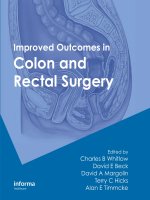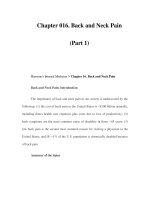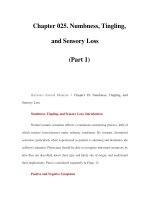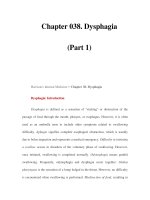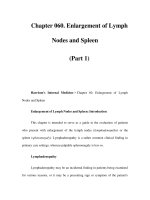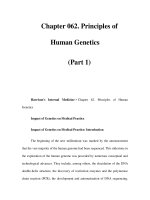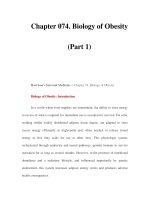Opthalmic microsurgical suturing techniques - part 1 ppsx
Bạn đang xem bản rút gọn của tài liệu. Xem và tải ngay bản đầy đủ của tài liệu tại đây (782.48 KB, 15 trang )
Marian S. Macsai (Ed.)
Ophthalmic Microsurgical Suturing Techniques
Marian S. Macsai (Ed.)
Ophthalmic
Microsurgical
Suturing Techniques
With 289 Figures, mostly in Color
123
Marian S. Macsai, MD
Professor and Vice Chair Ophthalmology
Northwestern University
Chief, Division of Ophtho
Evanston Northwestern Healthcare
2050 P ngsten Rd.
Glenview, Il 60025
USA
ISBN-10 3-540-28069-3 Springer Berlin Heidelberg New York
ISBN-13 978-3-540-28069-9 Springer Berlin Heidelberg New York
Library of Congress Control Number: 2006935423
is work is subject to copyright. All rights are reserved, whether the whole or part of the material is con-
cerned, speci cally the rights of translation, reprinting, reuse of illustrations, recitation, broadcasting, repro-
duction on micro lms or in any other way, and storage in data banks. Duplication of this publication or parts
thereof is permitted only under the provisions of the German Copyright Law of September 9th, 1965, in its
current version, and permission for use must always be obtained from Springer-Verlag. Violations are liable for
prosecution under German Copyright Law.
Springer is part of Springer Science+Business Media.
Springer.com
© Springer-Verlag Berlin Heidelberg 2007
e use of general descriptive names, registered names, trademarks, etc. in this publication does not imply,
even in the absence of a speci c statement, that such names are exempt from relevant protective laws and regu-
lations an therefore free general use.
Product liability: e publishers cannot guarantee the accuracy of any information about dosage and applica-
tion contained in this book. In every individual case the user must check such information by consulting the
relevant literature.
Editor: Marion Philipp, Heidelberg, Germany
Desk Editor: Martina Himberger, Heidelberg, Germany
Production: LE-T
E
X Jelonek, Schmidt & Vöckler GbR, Leipzig, Germany
Illustrations: Albert R. Gattung + Regine Gattung-Petith, Edingen-Neckarhausen, Germany
Typesetting: Arnold & Domnick, Leipzig, Germany
Cover Design: Frido Steinen-Broo, EStudio Calamar, Spain
Printed on acid-free paper 24/3100/YL 5 4 3 2 1 0
This eBook does not include ancillary media that was packaged with
the printed version of the book.
Dedication
For my husband, Jack,
and his never ending support and love.
For Ezra, Max and Emma,
my continued sources of
inspiration and joy.
For my parents who taught me
to learn, to teach and to enjoy life.
Preface
In any surgical eld, the importance of suturing is self-
evident. In eye surgery, due to the lack of elasticity of
the tissues and the in uence of sutures on the visual
outcome, proper microsurgical suturing technique is
paramount. Inappropriate or careless suture placement
and knot tying can impact visual function. If wound
construction and closure are not astigmatically neutral,
the visual outcome will be altered and further surgical
intervention may be required. Wound related compli-
cations are more severe in the eye than in the skin. e
close proximity of tissues allows for rapid spread of in-
fection and the limited blood supply inhibits treatment.
e same limited blood supply alters wound healing.
e translation of hand tying techniques, intro-
duced in every medical school curriculum, to micro-
surgical instrument tying is not obvious. Essential dif-
ferences exist in all aspects of ophthalmic microsurgical
suturing techniques, from the use of the microscope
itself to the instrumentation, tissue tactics, suture ma-
terial and knot construction. e experienced surgeon
shares the challenges that face surgeons in training, as
they attempt to master new skills and handle more
complicated cases. e role of wound closure and su-
turing techniques are basic building blocks for every
ophthalmic surgical procedure. Breaking down the
complexity of microsurgical suturing to each of the
numerous components required for tissue apposition
that does not alter the function of the eye or impair the
surgical outcome is the goal of this text.
Expert surgeons from di erent specialties have con-
tributed their time and knowledge to the creation of
this text. e uniform layout with key points identi ed
at the beginning of each chapter allows the reader to
quickly locate a particular technique. e authors have
made great e orts to describe each technique in a step-
by-step fashion, so that the reader can reproduce the
technique on their own. Accompanying digital video
clips of surgical footage clarify and demonstrate the
di erent techniques. Mastery of basic and advanced
ophthalmic microsurgical suturing techniques will fa-
cilitate expansion of any surgeon’s armamentarium.
As ophthalmic surgery advances, a variety of skills
are needed for the surgeon to stay current. is text
o ers the reader ophthalmic microsurgical suturing
techniques that decrease the risk of postoperative in-
fection and result in astigmatically neutral wound clo-
sure. Equipped with the knowledge of alternative tech-
niques, when complications arise, the reader can
decrease the need for further surgical intervention and
improve their surgical outcomes.
Acknowledgements
A text of this diversity is not possible without the input
and help of many authors. I thank each of the authors
who have freely contributed their expertise on an ex-
tremely tight schedule. Each was patient with the con-
tinuous revisions, illustrations, and video issues. Your
continued help and support made this idea a reality. I
could not have assembled all this material without
Peggy Dow, who kept me organized and on track. A
special thanks goes to all the people at Springer who
gave so much to this project, especially Marion Philipp
and Martina Himberger. I thank Renee Gattung for
her expert illustrations, and Patrick Waltemate at
LE-TeX for his patience.
Contents
1 The Physics of Wound Closure,
Including Tissue Tactics . . . . . . . . . . . . . . . . . . . . . . 1
Larry Benjamin
2 Needles, Sutures, and Instruments . . . . . . . . . . . . 9
Jennifer H. Smith and Marian S. Macsai
3 Knot-Tying Principles and Techniques . . . . . . . . 21
Anthony J. Johnson and R. Doyle Stulting
4 Microsurgical Suturing Techniques:
Closure of the Cataract Wound . . . . . . . . . . . . . . . 29
Scott A. Uttley and Steven S. Lane
5 Suturing an Intraocular Lens . . . . . . . . . . . . . . . . 37
Julie H. Tsai and Edward J. Holland
6 Corneal Suturing Techniques . . . . . . . . . . . . . . . . 49
W. Barry Lee and Mark J. Mannis
7 Trauma Suturing Techniques . . . . . . . . . . . . . . . . 61
Marian S. Macsai and Bruno Machado Fontes
8 Iris Reconstruction . . . . . . . . . . . . . . . . . . . . . . . . . . 71
Steven P. Dunn and Lori Stec
9 Sclera and Retina Suturing Techniques . . . . . . . 85
Kirk H. Packo and Sohail J. Hasan
10 Glaucoma Surgery Suturing Techniques . . . . . 101
Joanna D. Lumba and Anne L. Coleman
11 Amniotic Membrane Suturing Techniques . . . 107
Sche er C. G. Tseng, Antonio Elizondo,
and Victoria Casas
12 Strabismus . . . . . . . . . . . . . . . . . . . . . . . . . . . . . . . . 117
Mark J. Greenwald
13 Refractive Surgery Suturing Techniques . . . . . 129
Gaston O. Lacayo III and Parag A. Majmudar
14 Pterygium, Tissue Glue, and the Future
of Wound Closure . . . . . . . . . . . . . . . . . . . . . . . . . . 135
Sadeer B. Hannush
Subject Index . . . . . . . . . . . . . . . . . . . . . . . . . . . . . . 141
List of Contributors
Larry Benjamin
Department of Ophthalmology
Stoke Mandeville Hospital
Mandeville Road
Aylesbury, Bucks HP21 8AL, UK
E-mail:
Victoria Casas
Ocular Surface Center, P.A.
7000 SW 97th Ave., Ste. 213
Miami, FL 33173-1492, USA
E-mail:
Anne L. Coleman
Jules Stein Eye Institute
100 Stein Plaza, #2118
Los Angeles, CA 90095-7065, USA
E-mail:
Steven P. Dunn
Michigan Cornea Consultants
29201 Telegraph Rd., Ste. 101
South eld, MI 48034-7630, USA
E-mail:
Antonio Elizondo
Ocular Surface Center, P.A.
7000 SW 97th Ave., Ste. 213
Miami, FL 33173-1492, USA
Bruno Machado Fontes
Av. des Americas 2300 / B, cs 27
Rio de Janeiro, RJ, Brazil 22640-101
E-mail: ;
brunofontes@o almo.epm.br
Mark J. Greenwald
Department of Ophthalmology and Visual Science
University of Chicago
5841 S. Maryland Avenue, M/C 2114
Chicago, IL 60637, USA
E-mail:
Sadeer B. Hannush
Cornea Service, Wills Eye Hospital
Je erson Medical College, Philadelphia, PA
Correspondence:
400 Middletown Blvd. Suite 110
Langhorne, PA 19047, USA
E-mail:
Sohail J. Hasan
Ingalls Hospital Professional Bldg.
71 West 156th St., Ste. 400
Harvey, IL 60426, USA
Edward J. Holland
CEI-NKY
580 South Loop Rd., Ste. 200
Edgewood, KY 41017, USA
E-mail:
Anthony Johnson
Cornea/Refractive Surgery
SAUSHEC Ophthalmology
3851 Roger Brooke Drive
Fort Sam Houston, Tx 78234, USA
E-Mail:
Gaston O. Lacayo III
Rush University Medical Center
Department of Ophthalmology
1725 W. Harrison St., Ste. 928
Chicago, IL 60612, USA
E-mail:
Stephen S. Lane
280 N. Smith Ave., Ste. 840
St. Paul, MN 55102, USA
E-mail:
W. Barry Lee
Eye Consultants of Atlanta
95 Collier Rd., Ste. 3000
Atlanta, GA 30309, USA
E-mail:
XIV
Joanna Lumba
1101 Welch Road, Suite B2
Palo Alto, CA 94304, USA
E-mail:
Marian S. Macsai
Professor and Vice Chair Ophthalmology
Northwestern University
Chief, Division of Ophtho
Evanston Northwestern Healthcare
2050 P ngsten Rd.
Glenview, Il 60025, USA
Parag A. Majmudar
Rush University Medical Center
Department of Ophthalmology
1725 W. Harrison St., Ste. 928
Chicago, IL 60612, USA
E-mail:
Mark J. Mannis
Department of Ophthalmology
University of California
4860 Y St., Suite 2400
Sacramento, CA 95817, USA
Kirk H. Packo
Rush University Medical Center
Department of Ophthalmology
1725 W. Harrison St., Ste. 945
Chicago, IL 60612, USA
E-mail:
Jennifer Hasenyager Smith
2032 Valor Ct.
Glenview, IL 60026, USA
E-mail:
Lori Stec
Beaumont Eye Institute
3601 W. irteen Mile Road
Royal Oak, Michigan 48073, USA
R. Doyle Stulting
Emory Vision
875 Johnson Ferry Road
Atlanta, GA 30342, USA
E-mail:
Julie H. Tsai
University of South Carolina School of Medicine
Dept of Ophthalmology
Four Medical Park, Suite 300
Columbia, SC 29203, USA
E-mail:
Scheff er C. G. Tseng
Ocular Surface Center, P.A.
7000 SW 97th Ave., Ste. 213
Miami, FL 33173-1492, USA
E-mail:
Scott A. Uttley
St. Paul Eye Clinic
2080 Woodwinds Dr.
Woodbury, MN 55125-2523, USA
E-mail:
Chapter 1
Key Points
Principles of wound closure vary, depending
on whether the wound is extraocular or in-
volves opening the pressurized globe and sub-
sequent closure. Preparation, avoidance of
infection, and maintaining wound integrity
are vital in good wound management.
When suturing, the tissue should be well con-
trolled to stabilize the area through which the
needle passes. Desired results are best achieved
when this is done.
Closure of the skin of the eyelid is comparable
to skin closure elsewhere. Di erences exist in
the struc ture detail(s) included in the closure.
ere are a num ber of techniques for working
with the lid, con junctiva, and cornea and
sclera.
Because of the in exible nature of the cornea
and sclera, tissue suturing here requires pre-
cise suture placement.
Successful ophthalmic wound closure results
from proper technique modi cation and su-
ture tension.
1.1
Introduction
e closure of wounds in surgery relies on apposing
surfaces and planes of tissue so that they can heal in an
appropriate fashion. Knowledge of the biology of
wound healing is important, as is being able to modify
the processes involved to achieve the desired wound
architecture in an appropriate time. When considering
wound construction or repair in the cornea, wound
anatomy and healing can both have a dramatic e ect
on visual outcome a er the surgery because of the ef-
fect of surgically induced astigmatism on the corneal
surfaces. Similarly, poor wound repair on the eyelid
margins can have a long-term e ect on the ocular en-
vironment by a ecting lid closure and tear ow. is
chapter addresses the forces and vectors involved in
wound closure, the tactics used to achieve the desired
e ects, and how these relate to clinical principles.
•
•
•
•
•
1.2
Wound Architecture
1.2.1
Principles of Wound Closure
e principles of wound closure vary, depending on
whether the wound is extraocular or involves opening
the pressurized globe and subsequent closure. Para-
mount in the sequence of good wound management is
preparation. is means adequate cleaning of surgical
surfaces, excellent aseptic technique, as well as thor-
ough postoperative care.
Avoiding infection is the best way to ensure wound
integrity and healing in a timely fashion. In the eyelids,
infection a er surgery is uncommon, as there is a plen-
tiful blood supply, but in the cornea and cavities of the
globe, infection will last longer, cause more devasta-
tion, and be more di cult to eradicate.
One of the overriding principles of wound closure
is to keep the integrity of the body cavities intact and
prevent ingress of infectious agents. In addition, when
suturing the optical surfaces of the eye (any part that
a ects corneal curvature), care must be taken to avoid
excessive astigmatic change while maintaining the in-
tegrity of the globe.
Choice of instrumentation is important, as some
instrument tips may damage the delicate corneal tis-
sues more than others. Toothed forceps will grasp tis-
sue well but will puncture it. Notched forceps are more
gentle and may be preferred, but under some circum-
stances where the tissue is edematous (such as a er
trauma), multiple attempts to grasp the tissue with
notched forceps may result in further maceration and
swelling, whereas a single sure grasp with toothed for-
ceps may be preferable.
Microsurgery is distinctly di erent from general
surgery. e operating microscope forces the surgeon
to assume a particular posture that o en must be
maintained for several hours; the surgeon should sit in
a natural position, leaning slightly forward, with a
straight back and relaxed shoulders. Both feet should
be at on the oor. e visual eld is restricted, as is
the space for manipulation between the microscope
The Physics of Wound
Closure, Including Tissue
Tactics
Larry Benjamin
1
2
and the operative eld. e operating microscope con-
sists of the following elements: oculars, beam splitter,
magni cation system, and objective. Both focus and
magni cation should be adjustable with a remote foot
control. e entire surgical eld can be surveyed sim-
ply by dropping one’s gaze to the operative eld.
e function of sutures is to maintain apposition of
wound edges arti cially until scar tissue has attained
su cient strength. e ideal suture must appose the
incised tissue edges in their normal anatomic position
and provide adequate compression and minimal space
for the scar tissue to bridge. Until formation of s car
tissue is complete, the suture must maintain this ap-
position when external forces are applied. Simple in-
terrupted suture presses the wound margins together
and tends to assume a circular shape when tightened.
When overtightened or overcompressed, the posterior
aspect of the wound may gape, creating a stula. Over-
compression may cause the surgeon to place numerous
unnecessary sutures to keep the wound watertight.
Simple interrupted sutures produce inversion of the
wound edges as the suture assumes a circular shape.
Interrupted mattress sutures may produce inversion or
eversion of the wound edges, depending on their
placement and the degree of tightening. Continuous
sutures atten a convex wound and tend to straighten
out curved incisions. e continuous suture will de-
form the surface when the suture bites are placed ir-
regularly. Irregular sutures result from unequal suture
depth placement, unequal length of suture passes and
nonradial suture placement.
90°
Radial to
the wound
Fig. 1.1 e needle is passed perpendicular to the surface of
the tissue and exists equidistant from the point of entry when
viewed form the anterior perspective of the laceration
a
b
c
Fig. 1.2 a A er the knot is tied and the ends are cut short,
the suture is grasped with smooth forceps and rotated into
the tissue; care must be taken to avoid a twisting motion that
may torque the tension on the suture and result in a shearing
force that tears the tied suture. b e knot is then grabbed
and rotated in the reverse direction. c e suture knot is now
just beneath the surface of the tissue, and the ends extend
away from the wound. is placement of the knot will facili-
tate removal as long as the knot is pulled out in a manner
that does not require the knot to traverse the wound inter-
face
Larry Benjamin
3
1.3
Suture Placement
Tissue must be properly held in order to stabilize the
area of tissue the needle is driven through. If this ma-
neuver of passing the needle through the wounds edge
is controlled, the desired results are achieved (Figs. 1.1
and 1.2). Using 0.12 mm forceps, the tissue should be
held with the two-teeth side of the forceps on the same
side of the tissue through which the needle is being
driven.
e needle should be two thirds of the way from the
point of the surgical needle and held at a 90° angle
from the needle holder. e needle must be parallel to
the tissue plane (deviation will lead to tissue laceration
with a side cutting spatulated needle), and slip (if not
over tightend) or surgeon‘s knots may be used when
tissue is under tension. A er the wound is closed, the
initial sutures may be replaced with astigmatically
neutral sutures, surgeon‘s knots (2:1:1), at the desired
tension, to avoid over compression of tissue, which can
easily happen with slip knots that are tied to tightly.
1.3.1
Suture Technique
e suture passes should be of equal depth in the tissue
on either side of the wound and of equal length. In this
way, the wound will appose correctly without wound
override or inducement of astigmatism. e greatest
accuracy is achieved when the needle is inserted per-
pendicular to the tissue surface and emerges perpen-
dicular to the wound surface (Fig. 1.3). is placement
causes minimal shi of the wound surface when the
suture is tied. e needle can be passed in two steps.
First, it is inserted perpendicular to the tissue surface,
and it emerges perpendicular to the wound surface.
e needle should be brought out through the wound
surface, and then reinserted into the opposing wound
surface perpendicular to the wound surface such that
it exits perpendicular to the tissue surface. When using
this technique, it is sometimes di cult for the surgeon
to determine the proper insertion site in the opposing
wound surface. Furthermore, it is important for the
surgeon to consider that the depth at which the exiting
needle exits should be the same depth as when the
needle enters the opposing wound surface. If the sur-
geon inadvertently changes the direction of the needle
when entering the opposing wound surface or exits
and enters at di ering depths, the resultant torque on
the tissue will displace the entire wound. Easier pas-
sage of the needle tip through the tissue at 90 degrees
can be accomplished by everting the distal lip of the
wound so the depth of the wound can be accurately
ascertained. is allows a atter trajectory of the nee-
dle through the tissue nd enables the surgeon to see
the depth of both sides of the wound and accurately
position the needle into the second half of the wound.
e incised tissue is xated with xation forceps,
and the needle position must be adjusted according to
the amount of tissue deformation caused by the for-
90°
90°
Correct
90°
90°
Incorrect Tissue override
a
bc
AB
AB
Fig. 1.3 A needle is passed in two steps. a e needle is rota-
ted posteriorly, and it enters the tissue surface in a perpen-
dicular fashion (90° angle) and emerges perpendicular to the
wound suture. b e same angle of penetration is followed
when the apposing tissue is entered perpendicularly and the
needle again emerges at a 90° angle to the tissue surface. is
method causes minimal shi of the wound surface when the
suture is tied. c is equal spacing of the suture results in
correct wound apposition; unequal suture passes or bites can
result in wound override and irregular astigmatism
Chapter 1 The Physics of Wound Closure, Including Tissue Tactics
4
ceps. e tissue should be xated at the position where
the suture is to be placed, not adjacent to this position.
e needle sha must be inclined posteriorly to allow
the tip of the needle to pierce the tissue at a right angle.
A deep semicircular stitch produces a large compres-
sion zone, which limits the number of interrupted su-
tures needed to close a wound. Care must be taken not
to overtighten the sutures. Overtightening of sutures
can shorten the suture track and deform the surround-
ing tissue, which interferes with wound closure. A
single overcompressed suture can disrupt the closure
of the full length of the wound. It is better to remove an
overcompressed suture than to place numerous cor-
rective sutures to provide countertension. ese cor-
rective sutures may make the wound watertight, but
the result increases astigmatism.
1.3.2
Force Vectors of Sutures
All sutures produce vector forces that act in various
directions as the suture is tightened. e vector forces
extend in three di erent directions: perpendicular to
the wound surface, parallel to the wound margin, and
perpendicular to the tissue surface. If a suture is placed
perpendicular to the wound surface, the force vectors
cause compression in a line where the suture plane in-
tersects with the wound surface. However, if the suture
is placed obliquely, the compression vector force is an
area on the wound surface; therefore, a lateral shi of
the wound is produced. is shi is also the result of
the vector force that is parallel to the wound margin.
is force is not generated when the interrupted su-
tures are placed perpendicular to the wound. In con-
tinuous sutures, the shi ing vectors of the bridging
segments of the suture can serve to neutralize the shi -
ing forces generated by each suture bite. e third vec-
tor component, perpendicular to the tissue surface,
results in two forces in opposite direction in the simple
interrupted suture. e rst component results in ever-
sion of the wound edge, and the second portion of the
suture generates a force resulting in inversion of the
wound edge. In the simple interrupted suture, these
forces cancel each other out, and they are in opposite
directions. Continuous sutures produce both inverting
and everting forces that are cancelled out if the loops
are placed very close together, otherwise, signi cant
irregularities of the tissue surface result. An example of
the continuous suture can be found in Chap. 6.
e e ects of compressing vectors are maximal in
the suture plane and diminish farther away from the
suture. Each interrupted suture generates a zone of
compression. e compressive e ect is maximal in the
plane between the point of suture entry and suture exit
and falls o laterally. e action of the suture can be
described in terms of force triangles extending laterally
from the suture. e width of these compression zones
depends on the length of the suture bites and the degree
of suture tension a er the suture is tightened. Adequate
wound closure is achieved when the zones of compres-
sion of each interrupted suture overlap (Fig. 1.4).
1.4
Lid Wound Closure
Closure of the skin of the eyelid is similar to skin clo-
sure elsewhere, although di erences may exist in the
detail of what structures are included in that closure.
For example, incorporating the tarsal plate into the
skin suture a er a ptosis repair will cause a skin crease
to form in the appropriate place. Essentially, lid skin
closure is performed by placing a central suture, divid-
ing the wound in half, and then dividing each half in
half again. Deciding how many sutures to use depends
on their length and tension. An adequate number of
sutures have been used when the zone of compression
of each suture overlap. Figure 1.4 shows the zone of
compression for a single suture, which is the e ective
zone of closure that a suture exerts when tied at its par-
ticular tension. ese zones should overlap slightly to
ensure that the wound will not open between the su-
tures, and the closer the sutures are together, the more
the adjacent compression zones overlap and the more
secure will be the wound.
Decisions about suture placement are important in
relation to their spacing, depth, tension, and length.
A > B = Watertight closure A < B = Wound leak
A
A
B
B
Zone
of
compression
Leak Leak
Fig. 1.4 Zones of compression.
Di erent lengths of suture bites
result in di erent zones of com-
pression. When the zones of com-
pression overlap, adequate wound
closure is achieved (arrows)
Larry Benjamin
5
Usually, a suture should be symmetrical across a
wound with equal depth and length across the wound.
Suture bites are made with the needle at 90° to the tis-
sue surface. Everting the wound edge is sometimes
necessary to be able to see the placement of the needle
tip as it enters the tissue (Fig. 1.5).
is also allows a view into the depth of the wound
to ensure that the needle engages the opposite wound
edge at the same depth. e suture track will some-
times be longer than the radius of curvature of the
needle, which will make the wound pout when the
needle is in both sides of the wound (Fig. 1.6).
e length of the suture track may be important in
skin wounds, because if placed too close to the wound
edge and made too tight, then avascular necrosis of the
skin edge can occur. Skin sutures are usually tied
slightly overtight to evert the edges together so that as
healing progresses and subdermal involution of tissue
occurs, the wound edges will end up at.
1.5
Lid Margin Repair
ere are a number of di erent techniques available
for repairing lid margins, but the principles are the
same. It is important to accurately align the three sur-
faces of the lid (skin, gray line, and conjunctiva) for an
adequate time for healing to occur.
If a tarsal plate suture is used then additional skin
sutures can be removed early (1 week), but if gray line
and skin sutures are used without a cardinal tarsal su-
ture, then they must be le in for 2 to 3 weeks to allow
proper healing, especially if the wound is under ten-
sion such as when a proportion of the lid length has
been removed in tumor removal or entropion repair. A
cardinal tarsal suture should be placed horizontally
parallel to the lid margin about 1 mm from its surface
and should be within the lid substance entirely. In
other words, the suture should not protrude through
either skin at the front of the lid or conjunctiva at the
back. A well-placed tarsal suture will provide the nec-
essary strength and tension for the lid margin to heal
with no notching, and will allow early removal of sup-
plementary skin and lid margin sutures.
1.6
Conjunctiva Wound Repair
When suturing the conjunctiva, the surgeon must recog-
nize the inherent tendency of the tissue to curl. When
the conjunctival tissue curls, there is some retraction of
the conjunctival epithelium. e retraction can be o set
by countertraction on the subepithelial tissue. e epi-
thelial layer can be recognized by its distinctive vascular
pattern. Application of balanced salt solution to the cut
margin of the conjunctival tissue makes this distinction
easier because Tenon’s capsule will appear white when
the bers are hydrated with the solution. Care must be
taken to recognize the margin of the surgical dissection
when suturing conjunctiva. When countertraction is
applied, toothed forceps, such as 0.12-mm forceps, may
be necessary to determine the margin of the surgical
dissection and apply countertraction. If countertraction
is not applied properly, inadvertent suturing of epithe-
lial tissue in a subepithelial space can result in the post-
operative formation of an epithelial inclusion cyst. Con-
junctival tissue is extremely compliant, and postoperative
adherence is accomplished rapidly because of the vas-
cular substrate. Frequently, a rapidly absorbable suture,
such as 8-0 collagen or 8-0, Vicryl is used to secure the
conjunctival tissue in place.
Everted
wound edge
Needle visible
in de
p
th of wound
Fig. 1.5 Everting the wound edge
Wound pouting due
to radius of curvature
of needle being greater
than that of the bite
Fig. 1.6 Pouting of the wound
Chapter 1 The Physics of Wound Closure, Including Tissue Tactics
